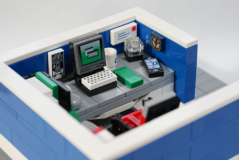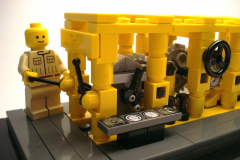Course Catalog


6 Lessons
Office TPM is primarily aimed at improving the office activities thru systematic analysis and timely actions. Cost reduction in Office TPM deals with different tools using which one can easily reduce the cost and make office activities more efficient. These tool are easy to understand and simple to implement . Negotiation skills are improved by knowing the amount of material and process involved. This course will enable one to understand the yield losses that occur during the process and bench mark the product correctly with similar products. By going thru the course one will get to know how to consider paramaters like proximity and volume of production to one’s advantage with respect to cost. Key takeaways: - classification of cost - Cost reduction methods - Efficient purchasing - Guidance for negotiation - Inventory control methods who should subscribe : - Employees of Companies embarking TPM journey - All who look for a better career in the industry - Final year Engg/ Management students to be industry ready
Add to cart

8 Lessons
Autonomous Maintenance Step-0: In this Step zero of autonomous maintenance, the goal is to increase basic understanding about machine components and train machine operators to perform maintenance activities to a certain level. The operators are briefed about the safety aspects also to perform AM activities and they are also given trainings regarding preparatory activities required to perform other steps of A.M. WHO SHOULD ATTEND: Shopfloor Leaders, Team leaders, Maintenance personnels, Managers, TPM Coordinators, Production Head, leaders, Quality personnels, Plant heads. KEY TAKE AWAYS: - Understanding of Autonomous Maintenance step0 - Understanding of 5s and TPM - Why step zero is required - Understanding 7 types of Abnormalities - What are the things required to be done for selecting the equipment Course Duration: 1 Hour
Add to cart

9 Lessons
Shop floor losses include all the losses that one would experience in the shop floor. They primarily are categorized as the following 1. Seven major losses that impede overall equipment efficiency 2. Losses that impede equipment loading time 3. Five Major losses that impede workers efficiency 4. Three major losses that impede efficient use of production subsidiary resources During the course each of this loss is dealt in detail and counter measure are also discussed. KEY TAKEAWAYS: - classification of losses - ECRS method - String diagram - Losses in a line - Loss reduction kaizens - Financial loss reduction method WHO SHOULD SUBSCRIBE: - Employees of Companies embarking TPM journey - All who look for a better career in the industry - Engg/ Management students
Add to cart

6 Lessons
The 4M analysis is a method for evaluation to identify which of the 4M conditions is responsible for a defect mode. This is a tool designed to identify, explore, and graphically display the possible causes related to a problem or condition. By going through the man, machine, material and method condition one will get good understanding about how the 4M condition will be effectively used. In this course the focus is on the details of 4Ms which people will usually forget to consider. To reduce defect one need the finer aspects of 4M which is very well explained in the course. If the defect is not going away what need to be done and the post analysis part is also given in detail KEY TAKEAWAYS: - 4Ms and quality characteristics - Detailed understanding of 4Ms - 4Ms for tools and jigs - How to prepare 4M survey chart - 4Ms and standards - 4Ms application in dealing with challenging defects WHO SHOULD SUBSCRIBE: - Employees of Companies embarking TPM journey - All who look for a better career in the industry - Engg./ Management students
Add to cart

7 Lessons
SMED, (Single Minute Exchange of Dies) is a systematic approach to reducing machine set-up and change overtimes. Originally devised by Shigeo Shingo of Toyota Motor Company in the early 1950s, this lean technique can dramatically shorten set-up time. It is a system for dramatically reducing the time it takes to complete equipment changeovers. the essence of the SMED system is to convert as many changeover steps as possible to “external” (performed while the equipment is running), and to simplify and streamline the remaining steps. WHO SHOULD ATTEND: Shopfloor Leaders, Team leaders, Maintenance personnels, Managers, TPM Coordinators, Production Head, leaders, Quality personnels, Plant heads. KEY TAKE AWAYS: - Understanding of OEE losses - Understanding of Setup loss - Why Setup - How to reduce setup time - Step wise implementation on machines Course Duration: 1 hour
Add to cart

7 Lessons
Profit I, this course is improvement is the key result area, that every organisation is focusing on. Though there are so many ways and means through which this is possible, how to develop the Human resource, which is the key asset to any organisation, will help the organisation to have constant growth in the area of Profit improvement. In this Pandemic situation also, how to train the human asset and how to use them effectively can be focused. In order to give a detailed knowledge about the various tools, which can improve the Labour Productivity and improving the Performance of the Equipment, this course is designed. KEY TAKE AWAYS: 1. Understanding Productivity 2. Profit through Loss elimination approach 3. Tools like Man machine chart, Fatigue elimination methodology, Job rotation 4. Methodology for Minor stop elimination 5. Methodology of speed loss elimination TARGET AUDIENCE: 1. All Business heads 2. All factory Managers 3. All Functional heads 4. All training managers 5. All line Supervisors
Add to cart

7 Lessons
OBJECTIVE: To understand the need for a defined Support service to Manufacturing To give a detailed idea on developing the support service and to improve the efficiency of the support staff To make the Supplier and customer friendly Support functions in the organisation WHY TO ATTEND THIS PROGRAM? In every business “Change is Permanent”. This change may be from any one out of the four from the external factors like, Market, competition, Product and the Technology. But the change is demanded by the Customer. In order to understand the changes, changing either our activities or System is essential. The change should be a continuous one. The contribution from the Admin can be effectively improved, more than the Manufacturing team, the Support services team can enable the business to be more profitable by taking care of the entire eco system on the supply chain, including the manufacturing KEY DELIVERABLES: Understanding the Support functions and their role Understanding the Office Process flow and WBS Understanding the Product and the Productivity in Office Understanding the work efficiency Tools for Improving the Individual work efficiency Tools for improving the efficiency of the team Understanding CPPS Brief understanding of DPR Basics of Makigami flow Improvement tools in RM Supply and the team Basic Improvement tools in SCM TARGETED AUDIENCE: All purchase heads Accounts Heads Store heads Supply chain heads Sales heads Marketing heads
Add to cart